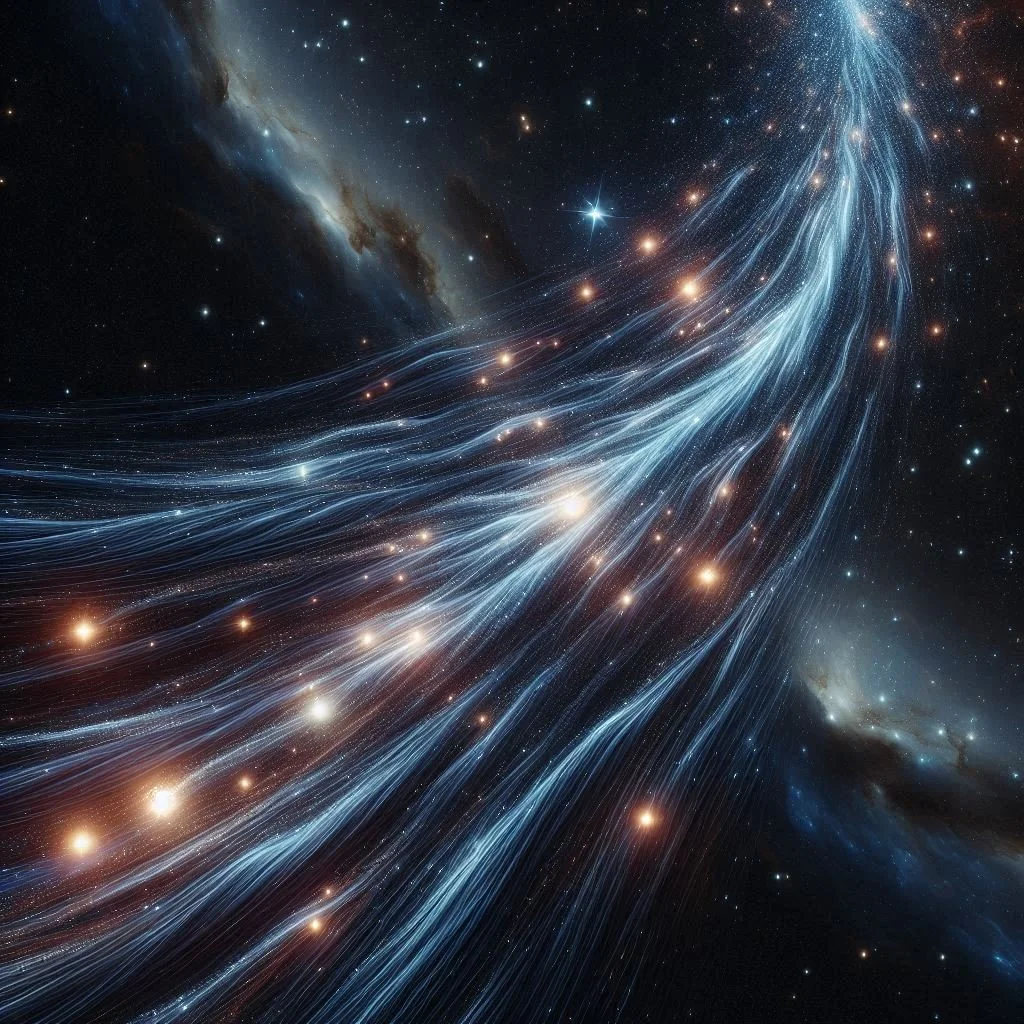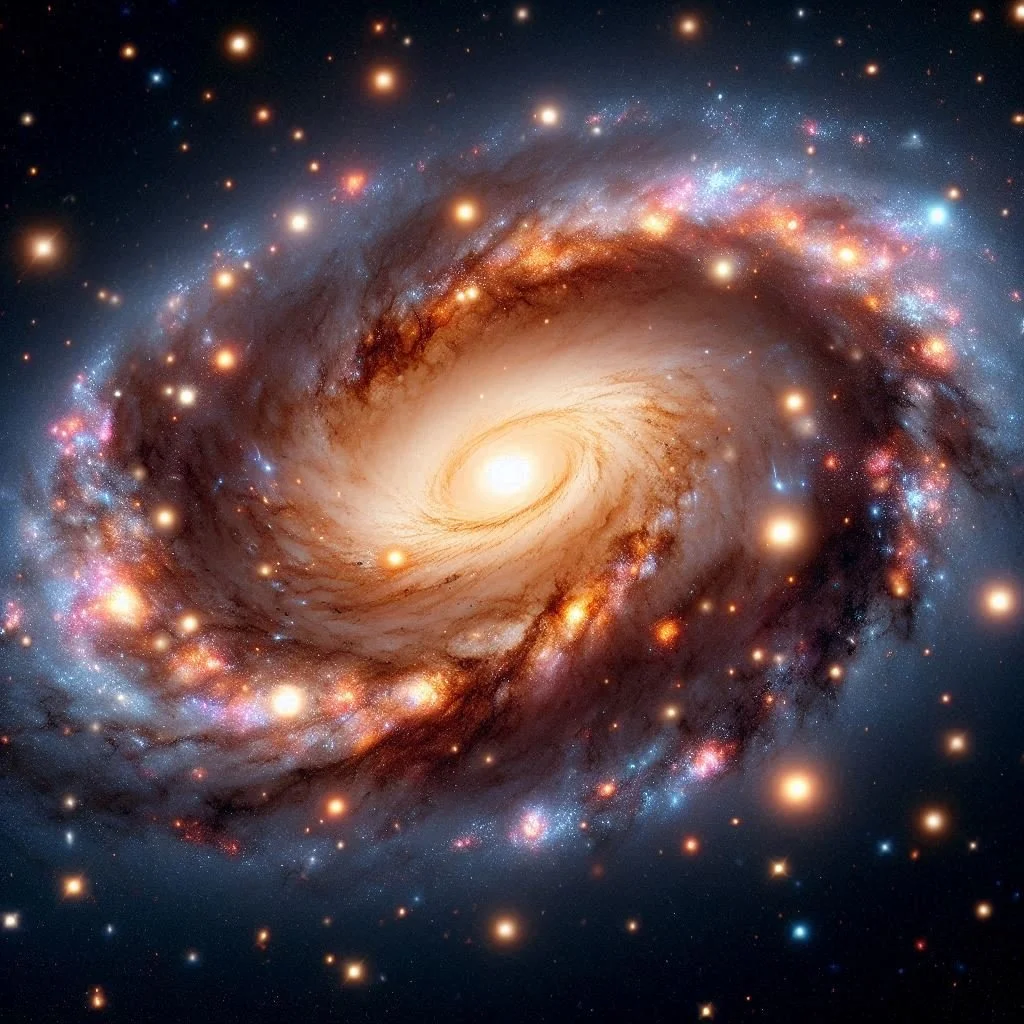
Discovering the Secrets of Bursty Star Formation in Dwarf Galaxies
The study explores how bursty star formation in dwarf galaxies imprints distinct chemical patterns, particularly in magnesium and iron abundances. Using models and APOGEE data from the Sculptor galaxy, researchers identified episodic star formation with quiescent periods of ~300 million years. These findings highlight the potential of chemical abundances to uncover galaxy formation histories and suggest future surveys will refine this understanding.

Exploring a Galactic Twin: NGC 3521 and the Milky Way in Metal-THINGS
The Metal-THINGS project studied NGC 3521, a galaxy resembling the Milky Way, to compare their chemical evolution. Oxygen and nitrogen abundance gradients suggest inside-out galaxy formation, with NGC 3521 showing stable inner oxygen levels but less outer mass exchange than the Milky Way. While structurally similar, their evolutionary differences highlight diverse processes in galaxy development, offering insights into the unique paths of Milky Way-like galaxies.

Unveiling Star Formation: How Our Galaxy's Past Shapes Its Future
This study examines how recent bursts of star formation shaped the Milky Way's chemical evolution and element distribution. Using models and data from Gaia, the authors show that these episodes create "wiggles" in the abundance gradient and alter element ratios like oxygen-to-iron. Star formation bursts also impact star migration and highlight the galaxy's dynamic past, offering insights into its future evolution.

Unveiling Trends in Exoplanet Atmospheres with JWST
Researchers analyzed JWST data to uncover atmospheric trends in eight gas giant exoplanets, focusing on sulfur dioxide (SO₂), carbon dioxide (CO₂), and carbon monoxide (CO). They found that SO₂ correlates with cooler, smaller planets, while CO₂ highlights metallicity and CO dominates in hotter atmospheres. A new SO₂-L vs. CO₂-L diagram offers a framework for classifying exoplanet atmospheres, setting the stage for deeper insights as more data becomes available.

Unveiling the Chemical Diversity of Interstellar Gas in the Solar Neighborhood
Ramburuth-Hurt et al. studied interstellar gas near the Sun, revealing significant chemical diversity. Using UV spectroscopy, they found large variations in dust depletion and estimated metallicities for individual gas clouds, uncovering some with super-Solar metallicities. Their work highlights the complexity of the interstellar medium and the importance of analyzing individual components to understand the Milky Way's evolution.

Exploring Stellar Halos: Unraveling Cosmic Histories with Chemical Clues
Stellar halos, the faint outskirts of galaxies, hold clues about galaxy formation. Using simulations, researchers divided halo stars into ex-situ, endo-debris, and in-situ categories, tracing their origins and chemical fingerprints. Most halo stars come from merged galaxies, with larger halos requiring more mergers. The study revealed a clear mass-metallicity relationship, linking chemical patterns to galaxy formation histories and enhancing our understanding of cosmic evolution.

Tracing the Origins of Alpha-Poor, Very Metal-Poor Stars
Alpha-poor very metal-poor stars are rare stars with unique chemical signatures, primarily explained by core-collapse supernova ejecta. Some stars also show contributions from sub-Chandrasekhar Type Ia supernovae. Pair-instability supernovae play a minimal role, highlighting the diversity of processes shaping early cosmic chemical evolution.

The Riddle of Cosmic Heavyweights: How Stars Forge Elements in the Early Universe
The CERES project investigates how early stars formed heavy elements through neutron-capture processes. Focusing on 52 ancient metal-poor stars, the study found that the rapid r-process dominated at low metallicities, while the slower s-process emerged later. Variations in element abundances suggest diverse nucleosynthesis events, with findings aligning well with galactic chemical evolution models, shedding light on the universe's early chemical enrichment.

Understanding the Evolution of Sun-like Stars in Nearby Stellar Streams
Lehmann et al. analyze Sun-like stars in nearby moving groups using precise measurements from the GALAH DR3 survey. They uncover age-metallicity trends, showing younger stars with consistent metallicity and older stars with declining metallicity. The Hercules stream stands out for hosting young, metal-rich stars which likely migrated from the inner Galaxy, revealing insights into Galactic evolution and stellar migration driven by the Galactic bar.

Unveiling the Chemical Legacy of the Sagittarius Dwarf Galaxy
The study examines the Sagittarius dwarf galaxy (Sgr dSph), revealing its star formation history and chemical evolution through high-resolution spectroscopy of 111 giant stars. The findings highlight a slower star formation rate compared to the Milky Way, distinct elemental patterns from neutron-capture processes, and contributions from ancient and younger stellar populations. Sgr's evolution offers insights into galactic mergers and enrichment in the Milky Way's halo.

Exploring the Heart of the Galaxy: Chemical Secrets of the Milky Way's Nuclear Star Cluster
The study analyzed the chemical compositions of nine stars in the Milky Way's Nuclear Star Cluster (NSC), focusing on α-elements like magnesium, silicon, and calcium. The results reveal that the NSC shares similar chemical trends with the Galactic bulge and thick disk, indicating a shared evolutionary history characterized by rapid star formation over billions of years. This challenges theories of recent dominant starbursts in the NSC.

Mapping the Milky Way's DNA: Stellar Parameters and Chemical Abundances Unveiled with S-PLUS
The S-PLUS survey analyzed 5 million Milky Way stars, estimating atmospheric parameters and chemical abundances using machine learning on multi-band photometric data. Neural networks outperformed random forests in accuracy, revealing trends like [Mg/Fe] bimodality and robustly mapping stellar properties. This cost-effective, scalable approach complements spectroscopy, offering new insights into Galactic evolution and paving the way for broader stellar population studies.

Revealing the Milky Way: Mapping the Stars and Their Movements Using the APOGEE Survey
Khoperskov and collaborators used APOGEE DR17 data and a novel orbit superposition method to map the Milky Way's stellar disc, revealing detailed chemo-kinematic structures. They identified distinct high-α (older, centrally concentrated) and low-α (younger, extended) star populations, supporting an inside-out galaxy formation model. The study highlights a complex disc evolution involving radial migration and an inner-outer disc dichotomy, offering new insights into the Milky Way's history.

The Goldilocks Zone of Europium: Exploring Planetary Habitability and R-Process Origins
The study by Carrasco et al. explores how europium, a proxy for uranium and thorium, affects planetary habitability by influencing magnetic field generation on rocky planets. They identify a "Goldilocks zone" of stellar metallicity, where planets are most likely to sustain stable magnetic dynamos critical for life. Additionally, the research links europium’s distribution to neutron star mergers, refining our understanding of r-process element production and its role in shaping habitable environments across the galaxy.

Tracing the Chemical Fingerprints of Early Stars through Elemental Patterns in the Milky Way
This study examines the chemical evolution of elements like carbon, nitrogen, oxygen, and lithium in 52 metal-poor giant stars in the Milky Way’s halo to understand the early Galaxy’s chemical history. By analyzing patterns in “mixed” and “unmixed” stars, the researchers found that mixed stars show evidence of internal processes altering their elemental composition, while unmixed stars retain the chemical signature of the early Galaxy. Lithium detection in some stars supported this classification, and stellar rotation was identified as a crucial factor in explaining observed nitrogen levels.

Tracing the Origins of ω Centauri: A Chemical and Orbital Investigation of Globular Clusters
This study explores ω Centauri’s origins by analyzing the chemical compositions and orbits of similar globular clusters, suggesting they may all stem from a common progenitor—an ancient dwarf galaxy disrupted by the Milky Way’s gravitational forces. Using data from the APOGEE catalog and advanced modeling techniques, six clusters were identified with chemical abundances and metallicity distributions closely matching ω Centauri. Their orbital characteristics further support an accretion origin, contributing to the understanding of how interactions with smaller galaxies have shaped the Milky Way.

Unveiling the Origins of the Leiptr Stellar Stream: A Disrupted Ultra-Faint Dwarf Galaxy?
The study by Kaia R. Atzberger and team analyzes the chemical composition of stars in the Leiptr stellar stream, suggesting it originated from a low-mass dwarf galaxy, not a globular cluster as previously thought. By examining the abundances of elements like iron, magnesium, and barium, the researchers found variations consistent with ultra-faint dwarf galaxies. This supports the idea that Leiptr is a remnant of one of the smallest and earliest galaxies that merged with the Milky Way.

Star Formation History of Gaia-Sausage-Enceladus: What Elemental Abundances Reveal
The study by Ernandes et al. investigates the star formation history of the Gaia-Sausage-Enceladus (GSE) galaxy using elemental abundances from its stars. The results show that GSE's star formation began gradually and extended for over 2 billion years. However, it ended abruptly, likely due to its merger with the Milky Way. Comparing GSE's chemical patterns to dwarf galaxies like Sculptor and Fornax reveals that GSE's history was similar to Fornax's slow growth but was cut short by external forces.
